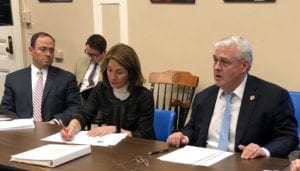Who is a member?
Our members are the local governments of Massachusetts and their elected and appointed leadership.

At the May 14 meeting of the Local Government Advisory Commission, Administration and Finance Secretary Michael Heffernan reports “good news” on state tax collections. Heffernan added that “we have to add a note of caution” until May and June numbers come in.
The close of fiscal 2019 is starting to look like a year ago, when state tax collections surged over the final months to reach $1.1 billion over the forecast, leading to a boost for the state’s rainy day fund and year-end supplemental spending, including for local capital projects.
After a slow start this year, state tax collections through the end of April beat expectations, up $1.8 billion compared to last year and $961 million (4.1 percent) over the fiscal year forecast.
While June is a key month for revenues that could make or break the recent trend, the reports through April – the May numbers won’t be out for another week or so – paint a picture of a strong overall economy.
The possibility of extra year-end state revenues could trigger a round of transfers to the state’s stabilization fund and an opportunity to add to local road and other capital programs and cover shortfalls in key municipal and school aid accounts.
Last year, in a year-end supplemental budget bill filed in July, the governor proposed an additional $50 million for local road and bridge projects (including $40 million for Chapter 90) and $30 million for the Clean Water Trust. The Legislature included funding for these programs in the final fiscal 2018 close-out budget bill enacted in October.
At the May 14 meeting of the Local Government Advisory Commission with Lt. Gov. Karyn Polito and Administration and Finance Secretary Michael Heffernan, Andover Town Manager and MMA Board member Andrew Flanagan asked that the governor recommend another round of funding for local capital projects and appropriations to cover shortfalls in fiscal 2019 local aid accounts for charter school mitigation payments and the special education circuit breaker program. According to a March analysis from the Department of Elementary and Secondary Education, the charter school mitigation account is underfunded by about $75 million, and the circuit breaker account is underfunded by $2.6 million.
Like last year, much of the above-forecast tax collections are attributable to the non-withholding part of the state’s personal income tax, mainly from capital gains. Because revenue from capital gains is hard to predict, state law limits the amount that can be used to support the state budget and transfers any extra to the stabilization fund. For fiscal 2018, this cap was about $1.17 billion. When actual collections totaled $1.68 billion, the cap resulted in $514 million being transferred to the stabilization fund, bringing the total balance to $2 billion when other transfers are included. The cap for fiscal 2019 has been set at $1.21 billion.
In more good fiscal news, the Lottery Commission increased its revenue projection in March by $29 million to $995 million, and it now looks like proceeds could exceed $1 billion for the year.